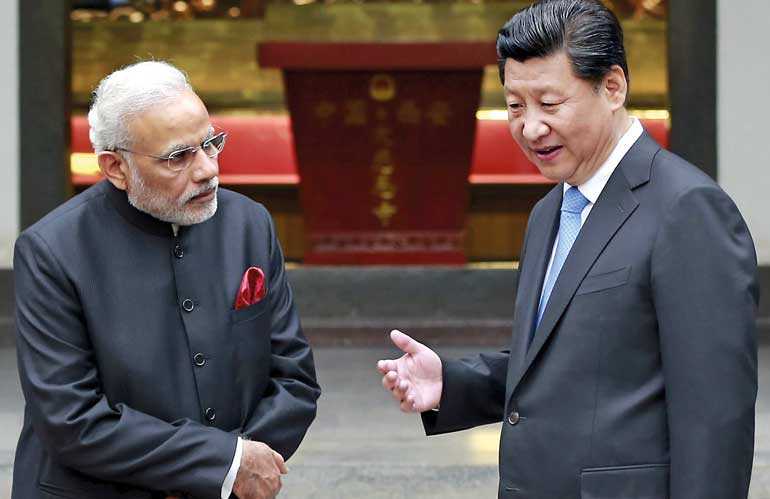Thursday Apr 18, 2024
Thursday Apr 18, 2024
Thursday, 6 June 2019 00:00 - - {{hitsCtrl.values.hits}}

By Marwaan Macan-Markar, Asia regional correspondent
Nikkei Asian Review: Indian Prime Minister Narendra Modi is preparing for a fiercer tug of war with China over neighbouring nations as his second term kicked off on Thursday. Whether India will strengthen its influence in the region will become clearer in countries such as Sri Lanka and Bangladesh, while it may distance itself further from Pakistan.
Setting the tone for his regional foreign policy will be the Maldives, where Modi visits on 7 to 8 June as his first international stop.
Modi will address the 87-member Parliament during his stay. Cooperation between India and the Maldives will ensure “stability in the Indian Ocean region,” Mohamed Nasheed, a former President who was just selected as the Speaker, said this week.
It is a calculated move, say South Asian analysts, as India and China fight for influence in an area that India regards as its backyard. They see the Maldives as a better diplomatic prize for Modi than Bhutan, the small Himalayan kingdom in South Asia that Modi visited first in his inaugural term.
New Delhi regained a political ally in the Maldives after a presidential election late last year, when pro-Indian President Ibrahim Solih defeated the pro-China – and openly anti-Indian – incumbent Abdulla Yameen.
By then, China had made inroads into the Maldives and India’s other South Asian neighbours, ranging from Sri Lanka and Bangladesh to Nepal, through its Belt and Road Initiative. India has struggled to match this multimillion-dollar network of infrastructure projects funded by Chinese loans.
Analysts expect Modi’s foreign policies to be tested in Bangladesh and Sri Lanka, both of which have Governments with close ties to New Delhi, despite some sticking points.
While bilateral ties between India and Bangladesh have strengthened during Modi’s first term, Dhaka is still waiting to resolve a long-standing dispute about sharing water of the Teesta River, which flows along the India-Bangladesh border.
As for Sri Lanka, fishing trawlers from India’s southern state of Tamil Nadu regularly enter Sri Lankan waters in the Indian Ocean, creating diplomatic spats.
“These countries will be looking to Prime Minister Modi to deliver on outstanding bilateral issues, such as finally signing the Teesta River accord with Bangladesh and resolving fishing disputes with Sri Lanka,” said Nilanthi Samaranayake, Director for Strategy and Policy Analysis at the Center for Naval Analyses, a Washington DC-based think tank.
Nepal also poses a diplomatic challenge. Indian interference in the landlocked-country’s politics resulted in an anti-Indian wave during the December 2017 general elections. A more pro-China left alliance now governs in Kathmandu.
So India may have to sweat to keep close ties with its neighbours.
“China’s engagement and presence in South Asia has taught India that maintaining a sphere of influence is not simply a function of telling your neighbours what to do – or not do – but disbursing resources that deny space to competitors,” said Aparna Pande, Director for the Initiative on the Future of India and South Asia at the Hudson Institute, a Washington D.C.-based think tank.
During his first term, Modi unveiled a ‘Neighbourhood First’ policy as his South Asian diplomatic blueprint. But the details of such policy may not be all the same. This shift was marked at his swearing-in ceremony in New Delhi on Thursday.
The welcome mat was only rolled out to leaders from select South Asian countries: Bangladesh, Bhutan, the Maldives, Nepal and Sri Lanka. Pakistan was not invited, reflecting the chill between the two countries.
Five years ago, ties were at least a little warmer. At Modi’s first swearing-in ceremony, Pakistan’s then-Prime Minister Nawaz Sharif was present.
Now, Beijing has its largest South Asian foothold in Pakistan through its BRI projects. The $62 billion China-Pakistan Economic Corridor begins at the port city of Gawdar, then heads inland via infrastructure projects that span transportation, energy and special economic zones.
With Pakistan depending more on China, and because of skirmishes over Kashmir in February, relations between the two longtime rivals could be frosty for a while.
South Asian diplomats had hoped that an eight-member regional grouping – the South Asian Association for Regional Cooperation – would get a new lease on life. SAARC’s eight members include Afghanistan.
But Modi’s choice of six SAARC members, sans Pakistan, for Thursday’s ceremony has dampened the prospects of this moribund body. His attention has shifted to another regional bloc where Pakistan is not a member: the Bay of Bengal Initiative for Multi-Sectoral Technical and Economic Cooperation.
Its members include Thailand and Myanmar, in addition to Bangladesh, Bhutan, Nepal and Sri Lanka.
According to Pande of the Hudson Institute, Modi’s regional foreign policy in his second term will take a South-Southeast Asia tilt. “Since ties with Pakistan are conflict ridden, the administration appears to be looking east,” she said.
It has opened the way for Japan to bolster India’s policies, according to Bernard Goonetilleke, a veteran Sri Lankan diplomat. “Modi will have Japan as India’s partner in some of the activities he proposes to carry out in the region.”